Manchester City history
Historical flashbacks
- The history of Maine Road – from 1923 to 2003
- Typical City – strange facts about City
- 1981 Documentary – the Malcolm Allison turmoil
- The inflatables banana craze – when football became fun again in the late 80ies
- 1996 in pictures – Gio Kinkladze
- After all that… this – by Bill Borrows (1998)
- Etihad stadium review – 2003 and beyond
Official information
Manchester City Football Club (nicknamed “The Blues” or “The Citizens” is a Premier League football club in Manchester, England. Founded in 1880 as St. Mark’s (West Gorton), they became Ardwick Association Football Club in 1887 and Manchester City in 1894. The club has played at the City of Manchester Stadium since 2003, having played at Maine Road from 1923. The club’s most successful period was in the late 1960s and early 1970s when they won the League Championship, FA Cup, League Cup and European Cup Winners’ Cup under the management team of Joe Mercer and Malcolm Allison. Currently City are in their second period of great success; winning two Premier League Championships, the FA-cup and League cup, as well as a Community shield between 2011 and 2014.
Club Chairmen
- John Chapman (1894-1902) – first spell
- Edward Hulton Jr (1902-1904)
- C. H. Waterhouse (1904)
- Waltham Forrest (1904-1905)
- John Allison (1905-1906)
- W.A. Wilkinson (1906-1914)
- John Chapman (1914-1920) – second spell
- Lawrence Furniss (1920-1928)
- Albert Hughes (1928-1935)
- Bob Smith (1935-1954)
- Walter Smith (1954-1956)
- Alan Douglas (1956-1964)
- Albert Alexander (1964-1971)
- Eric Alexander (1971-1972)
- Peter Swales (1972-1994) – 22 years – longest serving Chairman
- Francis Lee (1994-1998)
- David Bernstein (1998-2003)
- John Wardle (2003-2007)
- Thaksin Shinawatra (2007-2008)
- Khaldoon Al-Mubarak (2008-)
Club Managers
1889-1946 (10 managers in 57 years):
- Lawrence Furniss (1889-1893)
- Joshua Parlby (1893-1895)
- Samuel Ormerod (1895-1902)
- Tom Maley (1902-1906) – Won FA-cup
- Henry ‘Harry’ J Newbould (1906-1912)
- James Ernest Mangnall (1912-1924)
- David Ashworth (1924-1925)
-
Albert Edward Burns Alexander (1926) [Committee]
- Peter Hodge (1926-1932)
- Wilf Wild (1932-1946) – 14 years, 232 days – longest serving City Manager – Won League Championship, FA-cup, Charity Shield
1946-1980 (10 managers in 34 years):
- Sam Cowan (1946-1947)
- Jock Thomson (1947-1950)
- Les McDowall (1950-1963) – 12 years, 335 days – longest serving post WWII City Manager – Won FA-cup
- George Poyser (1963-1965)
- Joe Mercer, OBE (1965-1971) – General Manager until June 1972 – Most winning City Manager: – Won European Cup Winners Cup, League Championship, FA-cup, League Cup, Charity Shield
- Malcolm Allison (1971-1973) – First spell – Won Charity Shield
- Johnny Hart (1973)
- Ron Saunders (1973-1974)
- Tony Book (1974-1979) – General Manager until 8th October 1980 – Won League Cup
- Malcolm Allison (1979-1980) – Second spell
1980-1990 (7 managers in 10 years):
- John Bond (1980-1983)
- John Benson (1983)
- Billy McNeill, MBE (1983-1986)
- Jimmy Frizzell (1986-1987) – General Manager until Summer 1988
- Mel Machin (1987-1989)
- Tony Book (1989) – Caretaker
- Howard Kendall (1989-1990)
1990-2001 (9 managers in 11 years):
- Peter Reid (1990-1993)
- Tony Book (1993) – Caretaker – 19 years, 138 days since first spell as City Manager
- Brian Horton (1993-1995)
- Alan Ball (1995-1996)
- Asa Hartford (1996) – Caretaker
- Steve Coppell (1996) – 32 days – shortest serving [permanent] City Manager
- Phil Neal (1996) – Caretaker
- Frank Clark (1996-1998)
- Joe Royle (1998-2001)
2001-:
- Kevin Keegan, OBE (2001-2005) – 4 years, 292 days – longest serving City Manager since Tony Book (1980)
- Stuart Pearce (2005-2007)
- Sven-Goran Eriksson (2007-2008)
- Mark Hughes (2008-2009)
- Brian Kidd (2009) – Caretaker
- Roberto Mancini (2009-2013) – Won Premier League, FA-cup and Community Shield
- Manuel Pellegrini (2013-2016) – Won Premier League and League Cup (x2)
- Pep Guardiola (2016- )
Club Sponsors
- Saab (1982-1984)
- Philips (1984-1987)
- Brother (1987-1999)
- Eidos Interactive (1999-2002)
- First Advice (2002-2004)
- Thomas Cook (2004-2009)
- Etihad Airways (2009-)
The City Badges
All Manchester City badges have been inspired by the Manchester City Coat of Arms. The Coat of Arms is also the crest the club wears on most Wembley occasions. The shield base is red with three gold bands diagonally across to the right hand side representing the three rivers of Manchester: The Medlock, The Irwell and The Irk. The top segment shows a ship in full sail, a reference to the city’s trading base and to the Manchester Ship Canal. On a multicoloured wreath is a terrestrial globe, which symbols Manchester’s world trade. The bee in heraldic terms represents efficient industry, and to this day the bee is often used as a shorthand emblem of Manchester. The white heraldic antelope with its chain represents the engineering industries. The lion’s crown is a castle, a reference to the ancient Roman fort of Castlefield and the red roses they each wear on their shoulders are references to Lancashire. Below is a latin motto: “Concilio et Labore” – which can be translated to “By counsel and hard work”.
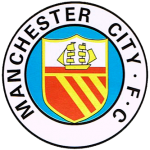

Between 1965 and 1997 City wore a circular badge which used the same shield as the current badge, inside a circle bearing the name of the club. It was based on designs which had been used on official club documentation since the mid-1960s, and was was updated in 1972 by a variation which replaced the lower half of the shield with the red rose of Lancashire. For the 2011 FA Cup Final, City used the usual badge with a special legend, but the Manchester coat of arms was included as a small monochrome logo in the numbers on the back of players’ shirts.
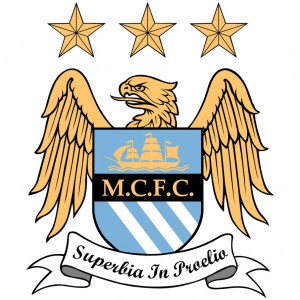 In 1997 the club introduced a new crest which looked more like a military emblem. At the top are three stars, underneath is a golden eagle and imposed on that is the new club crest. The ship is still there, underneath that is MCFC and then three diagonal strikes (like the round badge in the early 70’s?). At the bottom of the whole thing is a bit of latin, Superbia In Proelio which means Pride In Battle. Here is the official note on the reson for the change.
In 1997 the club introduced a new crest which looked more like a military emblem. At the top are three stars, underneath is a golden eagle and imposed on that is the new club crest. The ship is still there, underneath that is MCFC and then three diagonal strikes (like the round badge in the early 70’s?). At the bottom of the whole thing is a bit of latin, Superbia In Proelio which means Pride In Battle. Here is the official note on the reson for the change.
“Manchester City Football Club would like to announce that they have commissioned a new crest to replace the round badge that has only existed since 1974. The new club crest is based on elements from the original “Arms of the City of Manchester”, the crest which is still used by Manchester City PLC today and worn on the team shirt for all Wembley occasions. It retains the original shield set against an eagle taken from the Badge of the City of Manchester, dating from 1957, also originally found on the City of Manchester Crest, on the ribbon flowing from the knight’s helmet. Below the shield is the new club motto “Superbia In Proelio”, a Latin phrase translating to “Pride in Battle”. The three stars above the eagle constitute a design element that relate a more continental feel to the design“.
The club saw the eagle crest as a progressive, forward looking move, to take the club into the next millennium. In previous years an unsatisfactory situation had developed at Manchester City regarding the licensing out of the round badge on an ad hoc basis which has lead to a number of problems with counterfeit goods. This was leading to a devaluing of the Manchester City brand, and consequently its badge in both the modern market and in football.
In 2015 the club felt it was time to change the design again. The eagle crest which was supposed to give the club a more continental look and feel had some flaws that did not play well with the new owners. The busy and detailed design was not a good design for Internet and modern media platforms. Also some elements like the three stars simply felt out of place. After a 30-day consultation period and a series of lectures on the badges’ history by our own Gary James, during which thousands of fans fed back to the club as to whether, and if so how, they wanted the badge to evolve. Fans also gave their thoughts as to which symbols they considered most reflective of the Club and representative of the city of Manchester itself. Maybe not a bombshell but the majority of fans wanted a change back to the round design as used in the Club’s previous crests. 34% of the supporters expressed a desire to retain the existing Eagle badge shape.
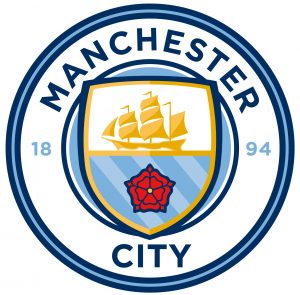 In addition the fans’ three favourite symbols, were included:
In addition the fans’ three favourite symbols, were included:
- The Manchester ship (voted for by 85% of the fans) which has appeared on all three of the club’s previous badges and symbolises the city’s trading links and its global outlook.
- The three rivers (67%) – the Irwell, Medlock and Irk – the lifeblood of the city, featured on Manchester’s coat of arms and which have featured on two of the club’s three previous badges.
- he red rose (60%) from the original Manchester coat of arms and one of the past badges, symbolising the Club’s early heritage and historic connection with Lancashire.
In addition the year of the club’s foundation, 1894, was included for the first time as a simple, but visible reminder of the club’s long-standing heritage and constancy.
On Boxing day 2015 the new badge was unveiled at City’s home game against Sunderland, or rather it was accidentally “leaked” through the Internet based on the trademark application made to the Intellectual Property Office (IPO) a couple of days before the announcement. The “leak” created quite the stir, mostly for the club which had planned the boxing day introduction for quite some time.
The return back to the basic form and traditional symbols was welcomed by the fans, although many had grown accustomed to the eagle. After all we had won the Premier League twice, the League cup twice, the FA-cup and a Shield with the eagle crest, while the previous one had given us 36 years of failure. Hopefully the new badge will deliver even better than the eagle.
The MCIVTA Crest
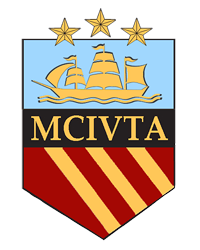 The MCIVTA Crest is mostly based on the shield found in the clubs crest. The ship, stars and the positioning of the text are all elements are similar to that of the club. However it uses the red background and gold stripes of the City Coat of Arms at the bottom half of the shield, and the stars are floating above the ship in a curved fashion. Both the club crest and the coat of arms have added birds and animals to the design but the MCIVTA has no further complicating elements making it more suitable for publishing on the Internet.
The MCIVTA Crest is mostly based on the shield found in the clubs crest. The ship, stars and the positioning of the text are all elements are similar to that of the club. However it uses the red background and gold stripes of the City Coat of Arms at the bottom half of the shield, and the stars are floating above the ship in a curved fashion. Both the club crest and the coat of arms have added birds and animals to the design but the MCIVTA has no further complicating elements making it more suitable for publishing on the Internet.
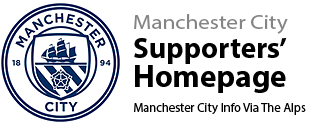
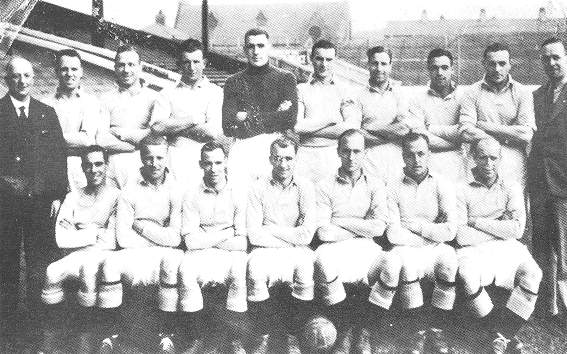
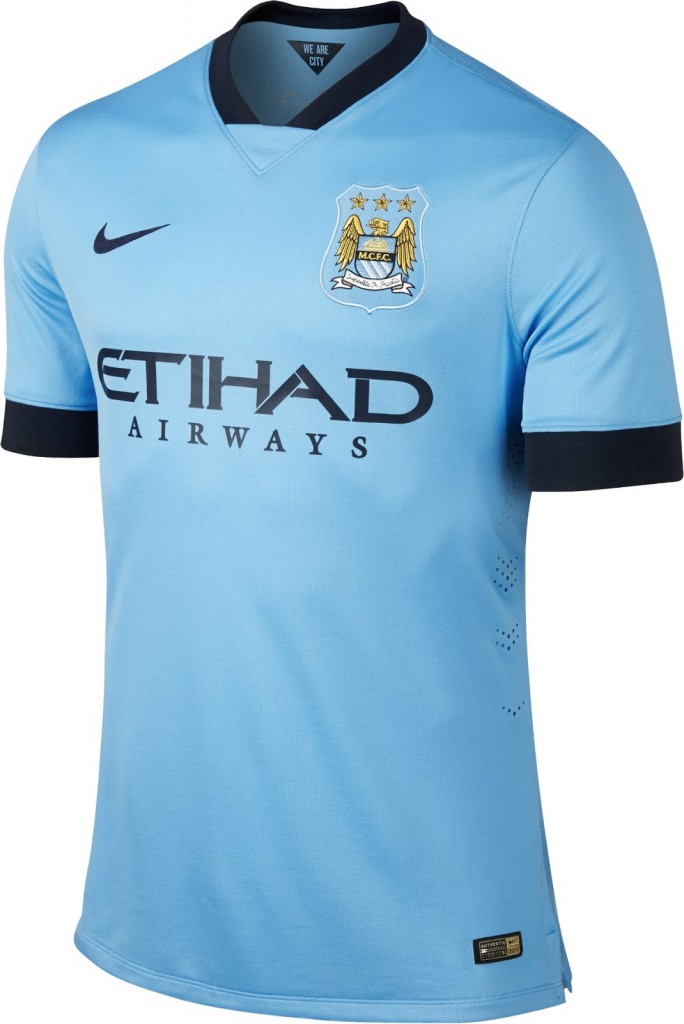
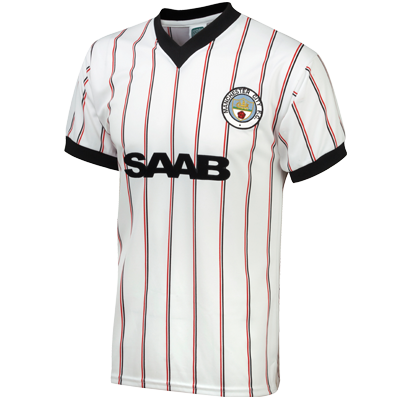





Trying to find anything on ; William ” Buxton ” Smith ( Man City player – 1897 to 1902 ) Anybody know what happened to him when he left in 1902 ?? Another team ! , Where he vanihed too !
http://www.whodoyouthinkyouaremagazine.com/forum/topic12228.html
Heres all the information I can find
I’m a man city fan and I want to no everything about my team
I love man city but my only problem is defense line is not doing good we have to get defender in january
am man city fan we need title this season